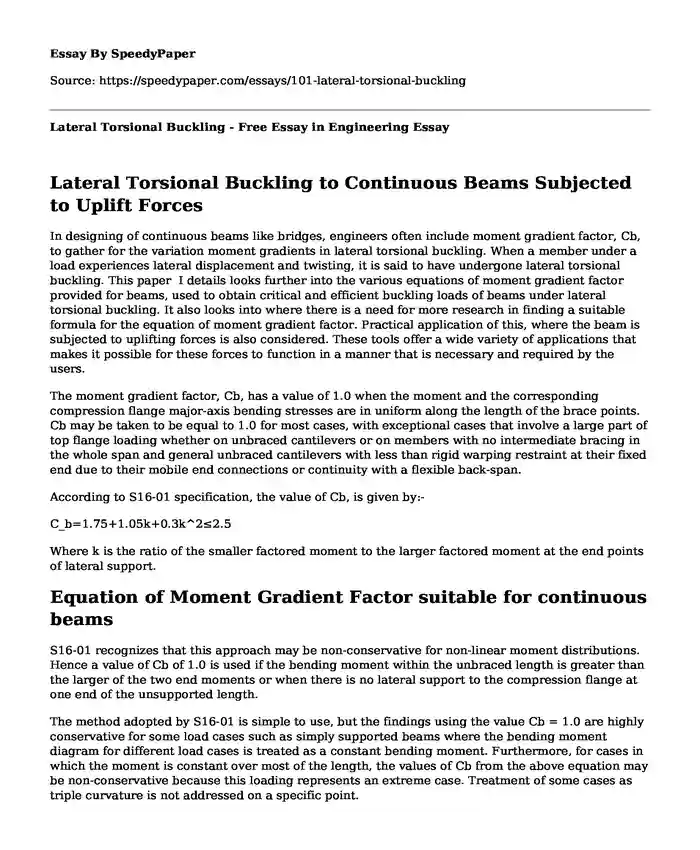
| Type of paper: | Essay |
| Categories: | Research Engineering Science |
| Pages: | 4 |
| Wordcount: | 839 words |
Lateral Torsional Buckling to Continuous Beams Subjected to Uplift Forces
In designing of continuous beams like bridges, engineers often include moment gradient factor, Cb, to gather for the variation moment gradients in lateral torsional buckling. When a member under a load experiences lateral displacement and twisting, it is said to have undergone lateral torsional buckling. This paper I details looks further into the various equations of moment gradient factor provided for beams, used to obtain critical and efficient buckling loads of beams under lateral torsional buckling. It also looks into where there is a need for more research in finding a suitable formula for the equation of moment gradient factor. Practical application of this, where the beam is subjected to uplifting forces is also considered. These tools offer a wide variety of applications that makes it possible for these forces to function in a manner that is necessary and required by the users.
The moment gradient factor, Cb, has a value of 1.0 when the moment and the corresponding compression flange major-axis bending stresses are in uniform along the length of the brace points. Cb may be taken to be equal to 1.0 for most cases, with exceptional cases that involve a large part of top flange loading whether on unbraced cantilevers or on members with no intermediate bracing in the whole span and general unbraced cantilevers with less than rigid warping restraint at their fixed end due to their mobile end connections or continuity with a flexible back-span.
According to S16-01 specification, the value of Cb, is given by:-
C_b=1.75+1.05k+0.3k^2≤2.5
Where k is the ratio of the smaller factored moment to the larger factored moment at the end points of lateral support.
Equation of Moment Gradient Factor suitable for continuous beams
S16-01 recognizes that this approach may be non-conservative for non-linear moment distributions. Hence a value of Cb of 1.0 is used if the bending moment within the unbraced length is greater than the larger of the two end moments or when there is no lateral support to the compression flange at one end of the unsupported length.
The method adopted by S16-01 is simple to use, but the findings using the value Cb = 1.0 are highly conservative for some load cases such as simply supported beams where the bending moment diagram for different load cases is treated as a constant bending moment. Furthermore, for cases in which the moment is constant over most of the length, the values of Cb from the above equation may be non-conservative because this loading represents an extreme case. Treatment of some cases as triple curvature is not addressed on a specific point.
The following equations of moment gradient factor Cb are applicable to continuous beams.
A closed form, empirical, expression value of Cb as proposed by Kirby & Nethercot given by:
C_b=12/(3(M_1/M_max )+4(M_2/M_max )+3(M_3/M_max )+2)
A valid Cb for any moment distribution modified by AISC LRFD is as shown below-
C_b=(12.5M_max)/(2.5M_max+3M_A+4M_B+3M_C )
Mmax is the maximum moment and MA, MB and MC are moments at quarter points as shown below. The upper limit is three.
Need for further Research
From the equations above, the value of Cb is found to vary from one formula to the other. There is the need to do further research to come up with an acceptable formula for finding moment gradient factor. Finite elements approach is one such method, and it gives lower Cb value than the AISC value. When finding the moment gradient factor, the loading condition, support condition and the beam slenderness is considered. Lateral torsional buckling is affected by the location of the load applied, the shape of the applied bending moment and end support condition. Section slenderness is affected by the length of the beam, the lateral bending stiffness of the flanges and torsional stiffness of the section. Where finite element approach is used to find the value of Cb, the value is slightly lower than that of AISC value. There is a need to find a reliability analysis to get a more acceptable value of the moment gradient factor, since the values got from the various equations above give varied values of Cb. There is a need to check other modes of failure in calculating the capacity of an I-beam with an inclusion of local flange buckling, web buckling, and shear failure. The closed-form expression formula need to be proofed further to ascertain its suitability
Conclusion
Equations (a), (b), (c) and (d) are all valid for use in a continuous beam system
The varied values of the moment gradient factor between the design codes and numerical results are taken to be negligible at this stage as further analysis are carried out. Calculation of elastic critical moment is important when dealing with lateral torsional buckling. This is necessary for present day designs and standards.
Cite this page
Lateral Torsional Buckling - Free Essay in Engineering. (2018, Sep 24). Retrieved from https://speedypaper.com/essays/101-lateral-torsional-buckling
Request Removal
If you are the original author of this essay and no longer wish to have it published on the SpeedyPaper website, please click below to request its removal:
- Use of Native American Mascots for Sports, Essay Example
- Essay Example on Alcohol Abuse
- Finance Essay Example: Rate of Return Versus Cost of Debt
- My Handover of Corporate Recruitment Division - HRM Essay Sample
- Are Barriers Effective in Deterring Unauthorized Migration? Free Essay
- Demand Letter, Law Essay Sample
- Free Essay. Library & Information Science Research
Popular categories




